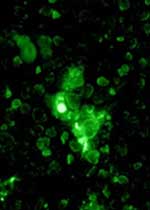| > |
Researchers at the University
of Pennsylvania Schools of Medicine and Veterinary
Medicine propose to
test for p53, a well-known tumor-suppressor protein, in
cancer patients to determine if
they are suitable candidates for proteasome inhibitors, a promising
class of anti-cancer drugs. |
| > |
The researchers speculate that responsive
myelomas are the ones retaining the p53 protein, which gets
stabilized during treatment and triggers self-destruction
of cancerous cells. |
| > |
This study appears online in the journal Blood,
in advance of print publication in June 2007. |
(PHILADELPHIA) – Researchers at the University of
Pennsylvania Schools of Medicine and Veterinary
Medicine have determined a way to pre-screen cancer patients to see if
they are suitable candidates for proteasome
inhibitors, a promising
class of anti-cancer drugs. They propose to test for p53, a well-known
tumor-suppressor protein that is broken down by cellular machinery
called proteasomes. This study appears online in the journal Blood,
in advance of print publication in June 2007.
 |
Green staining depicts tumor cells dying
after treatment with proteasome inhibitors. Here, the tumor
lacks p53, and only a fraction of the cells are killed.
Click on thumbnail
to view full-size image |
In cancer patients whose tumors do not produce p53, proteasome
inhibitors might be ineffective. This patient group could be spared
unnecessary treatment with possible harmful side effects. On the
other hand, proteasome inhibitors are highly effective against
lymphomas that do have the ability to produce p53.
“Proteasomes resemble paper shredders – they break
down proteins such as p53 into smaller pieces,” says senior
author Andrei
Thomas-Tikhonenko, PhD, Associate
Professor of Pathology. “A proteosome inhibitor effectively
jams the shredder so that p53 is not immediately broken down.”
In this study, the research team used a mutant strain of mice
in which p53 activity can be switched on and off. “In principle,
tumors in these mice could be obliterated by turning p53 back on,” says
Thomas-Tikhonenko. “The problem was that a protein called
MDM2 sent p53 into the teeth of the proteasome shredder.” The
proteasome inhibitor bortezomib (Velcade®) causes this jamming
process and restores p53 function. However, if p53 was inactivated
in the mice, bortezomib treatment failed to kill tumors. Similar
effects were seen with cell lines derived from human Burkitt’s
lymphomas. When implanted into mice, these lymphoma cells were
highly sensitive to the proteasome inhibitor, but as soon as p53
was removed, the inhibitor had no effect.
“These findings have important implications for clinical
practice,” Thomas-Tikhonenko adds. “Bortezomib is approved
by the Food and Drug Administration for the treatment of multiple
myeloma, another cancer of lymphoid cells. Yet, only a fraction
of multiple myeloma patients respond to the drug.”
The researchers speculate that responsive myelomas are the ones
retaining the p53 protein, which gets stabilized during treatment
and triggers self-destruction of cancerous cells. “If confirmed
experimentally, our hypothesis will serve to pre-select patients
with the best chances of success – those with p53 – and
spare the rest – those without p53 – the severe
side effects of bortezomib therapy,” explains Thomas-Tikhonenko.
There are two ways, suggest the researchers, to test for p53 production
in cancer patients. First, if MDM2 is expressed at abnormally high
levels, it is a good indicator that p53 is constantly being made.
Second, genetic tests can also be conducted to see if the malignant
cells still have the gene for p53 or if the portion of the chromosome
on which p53 is found has been deleted.
In addition to Thomas-Tikhonenko, Duonan
Yu and Martin
Carroll,
both from Penn, were co-authors. The National
Institutes of Health and the Commonwealth
of Pennsylvania Health Research Formula Fund provided funding for this research.
###
PENN Medicine is a $2.9 billion enterprise
dedicated to the related missions of medical education, biomedical
research, and high-quality patient care. PENN Medicine consists
of the University of Pennsylvania School of Medicine (founded in
1765 as the nation's first medical school) and the University of
Pennsylvania Health System.
Penn's School of Medicine is ranked #2 in the nation for receipt
of NIH research funds; and ranked #3 in the nation in U.S. News
& World Report's most recent ranking of top research-oriented
medical schools. Supporting 1,400 fulltime faculty and 700 students,
the School of Medicine is recognized worldwide for its superior
education and training of the next generation of physician-scientists
and leaders of academic medicine.
The University of Pennsylvania Health System includes three hospitals,
all of which have received numerous national patient-care honors [Hospital
of the University of Pennsylvania; Pennsylvania Hospital, the nation's
first hospital; and Penn Presbyterian Medical Center]; a faculty practice
plan; a primary-care provider network; two multispecialty satellite
facilities; and home care and hospice.
Penn Medicine is one of the world’s leading academic medical centers, dedicated to the related missions of medical education, biomedical research, excellence in patient care, and community service. The organization consists of the University of Pennsylvania Health System and Penn’s Raymond and Ruth Perelman School of Medicine, founded in 1765 as the nation’s first medical school.
The Perelman School of Medicine is consistently among the nation's top recipients of funding from the National Institutes of Health, with $550 million awarded in the 2022 fiscal year. Home to a proud history of “firsts” in medicine, Penn Medicine teams have pioneered discoveries and innovations that have shaped modern medicine, including recent breakthroughs such as CAR T cell therapy for cancer and the mRNA technology used in COVID-19 vaccines.
The University of Pennsylvania Health System’s patient care facilities stretch from the Susquehanna River in Pennsylvania to the New Jersey shore. These include the Hospital of the University of Pennsylvania, Penn Presbyterian Medical Center, Chester County Hospital, Lancaster General Health, Penn Medicine Princeton Health, and Pennsylvania Hospital—the nation’s first hospital, founded in 1751. Additional facilities and enterprises include Good Shepherd Penn Partners, Penn Medicine at Home, Lancaster Behavioral Health Hospital, and Princeton House Behavioral Health, among others.
Penn Medicine is an $11.1 billion enterprise powered by more than 49,000 talented faculty and staff.